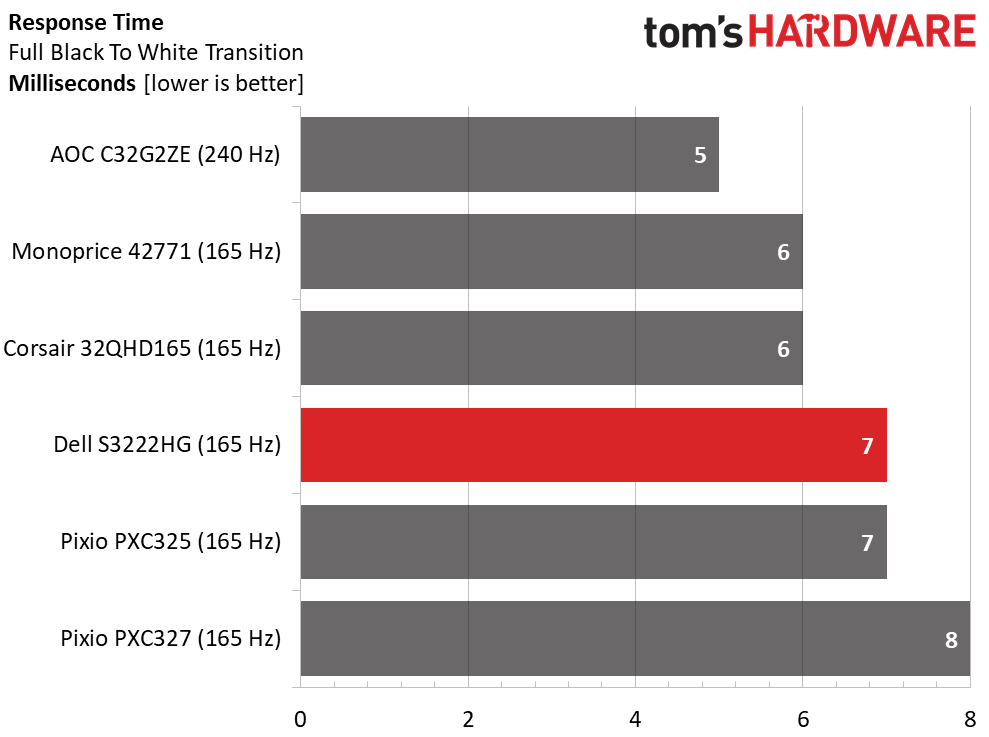Why you can trust Tom's Hardware
There aren’t many 32-inch FHD monitors out there, but I found two in my testing database, AOC’s C32G2ZE and Pixio’s PXC325. They are close in price to the S3222HG. I also included two 32-inch QHD screens, Corsair’s 32QHD165 and Pixio’s PXC327. To bring the panel count to six, I added Monoprice’s 42771, a 27-inch FHD/IPS panel that runs at 165 Hz.
Pixel Response and Input Lag
Click here to read up on our pixel response and input lag testing procedures.


The S3222HG has average response for a 165 Hz monitor. It’s also equal to most of the 144 Hz screens I’ve measured. The Corsair and Monoprice displays are a hair quicker, while the 240 Hz AOC is two hairs quicker. The difference is noticeable when objects or scenery move quickly from side to side. A one- or two-millisecond difference in response translates to more or less motion blur. 7ms delivers a smooth experience, but more Hertz is always better.
The S3222HG proved very responsive to control inputs in the total lag test. More skilled players than I will benefit from a 240 Hz or faster screen, but for casual players like me, 144 or 165 Hz gets the job done. This Dell will deliver a very good gaming experience for the price.
Viewing Angles
VA panels don’t usually impress me with their off-axis image quality, but the S3222HG is better than most. There is a roughly 30% light fall-off to the sides, but the color shift isn’t severe. A slight red/green tint can be seen in the middle brightness steps. The same is true of the vertical view and you can see a reduction in detail. This is caused by a change in gamma, which is typical of all LCD panels viewed from above.
Screen Uniformity
To learn how we measure screen uniformity, click here.
When looking at full black screen patterns in a dark room, I saw no issues with the S3222HG’s screen uniformity. There were no visible hotspots, edge bleed or glow areas on the screen. The meter detected a little extra brightness in the center zone, but I could not see this. Color uniformity was also excellent, with no aberrations observed. This is a very high-quality screen, especially considering its low price.
Get Tom's Hardware's best news and in-depth reviews, straight to your inbox.
Current page: Response, Input Lag, Viewing Angles and Uniformity
Prev Page Features and Specifications Next Page Brightness and Contrast
Christian Eberle is a Contributing Editor for Tom's Hardware US. He's a veteran reviewer of A/V equipment, specializing in monitors. Christian began his obsession with tech when he built his first PC in 1991, a 286 running DOS 3.0 at a blazing 12MHz. In 2006, he undertook training from the Imaging Science Foundation in video calibration and testing and thus started a passion for precise imaging that persists to this day. He is also a professional musician with a degree from the New England Conservatory as a classical bassoonist which he used to good effect as a performer with the West Point Army Band from 1987 to 2013. He enjoys watching movies and listening to high-end audio in his custom-built home theater and can be seen riding trails near his home on a race-ready ICE VTX recumbent trike. Christian enjoys the endless summer in Florida where he lives with his wife and Chihuahua and plays with orchestras around the state.
-
Endymio Describing a 32" 1080p monitor as "relatively low" pixel density is quite an understatement. The most popular monitor segment of 27" @ 1440p is nearly twice the pixel density, and a smartphone may have more 6 times the density.Reply
